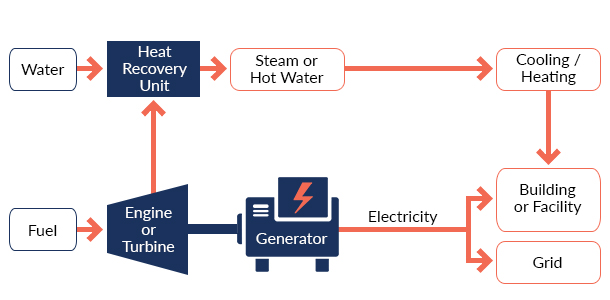Combined heat and power (CHP) is a highly efficient, combined process which integrates the production of usable heat and power. We’ve previously written a blog about the process, focusing on how it works and the various positives of using CHP.
Taking a more in depth look, we can look at how CHP can be utilised for hot water and heating in order to get the most out of the process. To keep a CHP system functioning in an efficient manner, there are a few fundamental requirements; the need for heat must be large enough to justify installing the system so that it is worth the investment. The amount of heat needed throughout both the day and changing seasons also needs to stay around the same figure so that the system can operate at its full potential at all times; if this doesn’t happen and the system is turned down, the efficiency is reduced.
In the UK, the biggest use of fossil fuels isn’t what you might assume. Despite with our increasing demand for electricity and transport, generating heat is where we burn the most fossil fuels. The conventional power stations produce heat as a by-product but throw it away; a gas-fired CHP system works by burning biogas or natural gas in a combustion chamber. The combustion produces a flow of hot air, driving a turbine- a generator then converts this rotational energy into electricity. Hot water is produced because after the hot air drives the turbine, it is then captured by a heat recovery boiler; which heats water and then passes it out through insulated pipes. Transporting heat over long distances is a challenge, and so for this reason, locating the system near the benefiting building and having insulated pipes are a must. The outputs of the CHP system doesn’t stop here; low grade heat also drives a steam turbine; producing more electricity. You may also hear of a CHP cooling system which produces power for air conditioners etc. this is produced by an absorption chiller; cooling in place of heating.

There’s more than one type of heat that can be produced by CHP. Low temperature hot water (LTHW), medium temperature hot water (MTHW), steam, and in the case of Combined Cooling, Heating and Power (CCHP also called Tri-Generation) chilled water. CCHP is best suited to sites with little to no summer heat load but which have a need for a cooling load.
Center Parcs, Woburn Forest in Bedfordshire is located in a 365 acre forest and offers an ‘escape back to nature.’ The company’s fifth development, it is the first that incorporates their own heating network. The business has won awards for their commitment to minimising their environmental impact, ranking as joint number one in the Carbon Reduction Commitment (CRC) performance league table. They state on their website, “as a sustainable business, we seek to benefit and improve the communities in which we operate. We aim to minimise our impact on the environment and encourage biodiversity when caring for Center Parcs’ forests and the wider surroundings.” The project was a huge undertaking, their aim was that this site will use 25% less energy than the average use of their previous four developments. It was achieved by installing 18km pre-insulated steel and plastic pipes, connecting their CHP and biomass powered energy center with the entire site; which includes 625 lodges. The sustainable energy system will now provide Woburn Forest with reliable and environmentally friendly heat; and though the initial investment was high, they will benefit from this system for years to come, working to reach their aim of cutting their energy use.
There is no denying the benefits of CHP. If you would like more information, or talk to one of our expert energy advisers about making your business more energy efficient, please get in touch!

